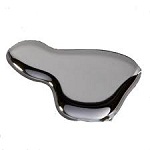Stools
Hard; Tenacious or crumbling; Small, knotty masses; Small, like sheep dung; Pale, white stools; Small pieces, pale, with mucus or streaked with blood; In the form of a marrow ribbon.
Before stool
Frequent desire, worse at night; Ineffectual straining; Protrusion of Haemorrhoids with the straining, which causes a pain as of ulceration.
During stool
Great straining with scanty stool, with pinchings in the Belly; Severe pains at the anus; Evacuation after a great length of time.
After stool
Continued tenesmus and prolapsus ani; Bleeding haemorrhoids.
Concomitants
Catarrhal fever and debility. Migraine. Bad taste in the mouth; pain in the gums: loss of, or irregular, appetite, or the appetite may not be impaired to a great extent; disgust for all substances, except for beer; salivation. Fullness and hardness of the abdomen; colic. Various manifestations of bilious symptoms. Yellow color of the skin and conjunctiva.
Generalities
Hirschell calls attention to Mercurius for the constipation which follows diarrhoea in acute cases, after a chill, and when there are gastric or inflammatory symptoms.
Espanet says, that the Corrosive sublimate is very useful in the constipation from pseudo-membranous inflammation of some portion of the large intestine and in haemorrhoidal colic with congestion of the liver and abdominal venous stasis.
Calomel, writes Dr. Gerson, of Dresden, seems to be more efficacious than Mercurius solubilis in the so-called haemorrhoidal colic, when it calls in general for Mercurius, in the subjects who have a well-marked condition of venous stasis in the lower abdomen, with a full and hard pulse, an obstinate constipation, and where the inguinal glands, as well as the left lobe of the liver, are slightly inflamed and tumefied. According to my experience Calomel appears to be almost a specific for obstinate constipation, where the signs of a violent hyperaemia of the mesocolon or a circumscribed exudative inflammation of the mucous membrane are present as objective causes of the constipation.
[Hempel and Arndt in speaking of Mercurius sol. in its relation to constipation write; Mercury will be found useless, unless this condition is depending on, or connected with, torpor of the liver or the pancreatic gland. Constipation may be a sequel of previous bilious or pancreatic diarrhoea. In such a case, Mercury is in homoeopathic rapport with it. The bowels may not be moved more than once or twice a week; the faeces have a dark-brown or green color; they are discharged in lumpy masses or balls loosely hanging together and covered with intestinal mucus. The cul-de-sac, or pouch of the rectum, sometimes becomes a receptacle for these lumpy masses, where they agglomerate in one compact ball, the passage of which through the rectum sometimes causes a great deal of acute pain, and may even be attended with slight haemorrhage. Sometimes the constipation is interrupted by an occasional attack of bilious diarrhoea.]
Jahr calls attention to Staphysagria for constipation with bad taste in the mouth, irregular appetite and pain in the gums, in those cases where Mercurius does not suffice.
Case 27
Chronic constipation, in a patient who presented a jaundiced teint, and suffered with pain in the liver and right shoulder with frequent nausea and obstinate chronic constipation, Mercurius cor., soon removed the whole trouble. – Dr. Usscher.

– BERNARD H,